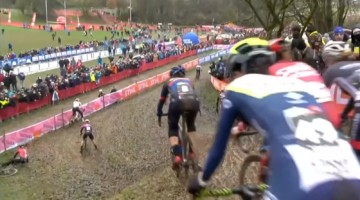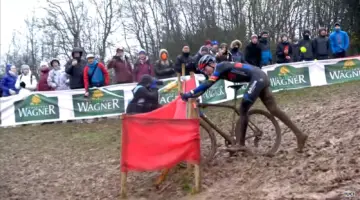John Meehan has slowly turned a December gathering of friends in an Iowa City field into one of the two biggest cyclocross races on U.S. soil this year. Meehan, aka The Grinch, worked in Iowa City as a doctor for a number of years before moving out to the West Coast. However, he still returns to Iowa several times each year to serve as the race director for the annual Jingle Cross festival.
Meehan and his team successfully bid for a World Cup race in 2015 and hosted just the second-ever U.S. cyclocross World Cup last September. Despite the high temperatures, the course and event received good reviews and Katie Compton and Wout van Aert took home victories in their respective races.
Cyclocross Magazine made the journey to the Grinch’s lair atop Mt. Krumpit to ask Meehan how the first Jingle Cross World Cup went and what his plans are for year two in 2017.
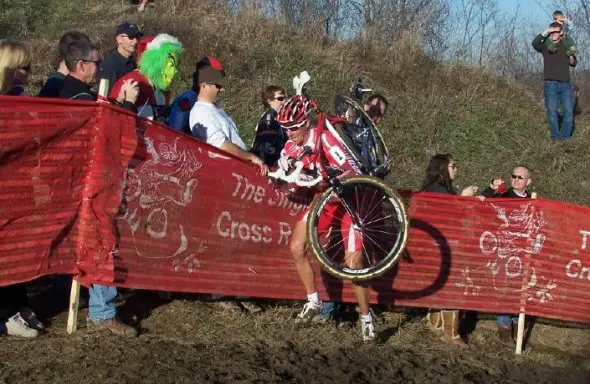
The Grinch is always lurking on Mt. Krumpit. We tracked him down for an interview. 2009 Jingle Cross. photo: courtesy
Interview with John Meehan, aka The Grinch
Cyclocross Magazine: I would say a lot of people love Jingle Cross and a lot of people across the Midwest consider it a must-see event. What is it about Jingle Cross that makes people want to come back each year?
John Meehan: I think it’s that we create such a fun atmosphere and try to create something for everybody. We have so many races—this year we have 65 races for riders of all abilities—and our focus is really on them. And then, oh by the way, there’s this pro race that they get to stay and watch. Imagine going to Yankee Stadium or Wrigley Field and seeing a World Series between the Yankees and the Cubs and then you get to stay and play a softball game between you and your buddies afterward. That’s what we’re trying to create, that atmosphere where I get to be part of this big event and I also get to watch it. I think people feel like they’re part of it, which is the key thing we really try to make.
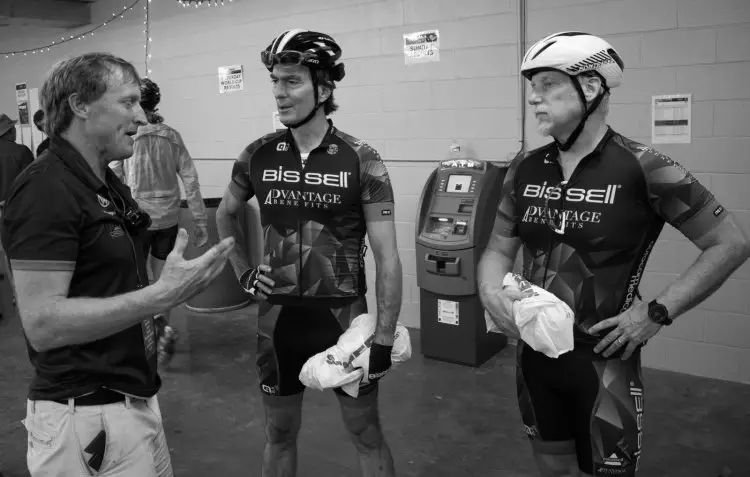
John Meehan’s attention to the needs of riders is one of the reasons Jingle Cross has been successful. 2016 Jingle Cross World Cup © A. Yee / Cyclocross Magazine
CXM: I think one thing being a U.S. World Cup, you hear a lot of questions about whether the course will be World Cup quality. Were you nervous at all about the course and event living up to the hype and expectations?
JM: No, not at all. We have paid attention to what the riders want. One thing we have heard at the U.S. cyclocross summit each year from the pro riders, and USA Cycling does a really good job having the pro U.S. riders talk to all the race directors each year, and one of the thing the pro riders say is the U.S. courses are too easy. They’re too flat, they’re not like Europe at all. When our top riders go over to Europe, they are sometimes decimated by the European World Cup-type courses.
We have always strived to make our C1 and C2 races as close to a World Cup as possible, as far as ability and difficulty level. That’s why Mt. Krumpit is the whole focus of the entire race. You get breaks by coming down onto the flatlands for a little bit, but then you’re going back up. Our whole philosophy is let’s make this like a European course as best we can. I think we accomplished that because we had some of the European riders tell us, “This is a World Cup course. This is hard.” This is what they want. They want something that is going to separate people, kind of makes a selection process. They really enjoyed it.
CXM: Were you excited when it poured during the week, or did you feel the course would hold up in any conditions? I mean, Friday night was gross.
JM: I look at it from two standpoints. Number one, when we had all that rain, it happened on Thursday night during set up. Everyone had come in to set up their tents and we had this unexpected, unpredicted huge storm. Tents got destroyed. Two of our three Jingle Cross tents got destroyed. A bunch of other people’s tents got destroyed by this freak rain and wind storm. We were like, how could this possibly happen at this point?
When you got to the racing, it was incredible. It was like, yeah that’s cool. It made for cool visuals and all that. But when you got to the parking, we had lost all our parking too. As far as the race goes, it made for an amazing race, but as far as infrastructure stuff, it took a toll. It’s a trade off.
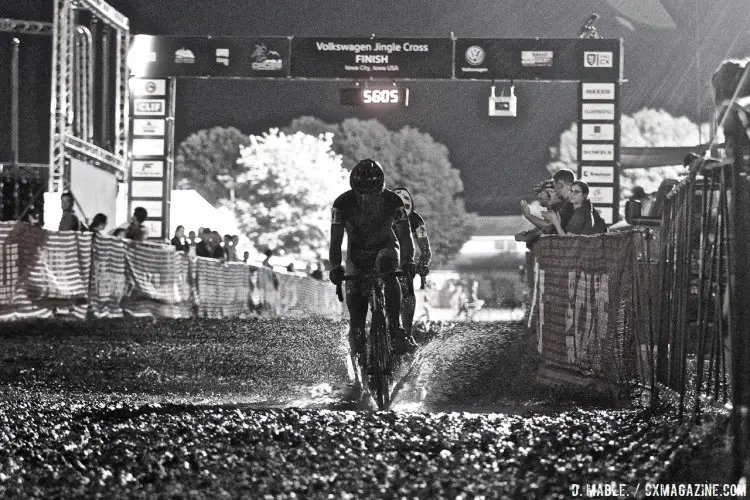
Heavy rains on Thursday created muddy conditions for Friday night’s C2 race at Jingle Cross in 2016. 2016 Jingle Cross Day 1, Elite Men. © D. Mable / Cyclocross Magazine
CXM: As a race director, how did you handle that? I could see a lot of folks freaking out. Are there behind-the-scenes stories of things going bonkers?
JM: Our famous quote that we like to keep saying every year as we’re moving along is “Nothing can go wrong now.” Because every time we turn around something is going to go wrong. You just have to roll with it and figure it out and move on. I have an absolutely amazing team of volunteers and my right-hand man was Todd Gillihan, and this year it’s Ben Anderson. These two guys were absolutely amazing at course set up and figuring out these sorts of problems. Plus I have an amazing team of people from the local convention bureau who helped deal with all the infrastructure problems with the parking and how to get people in and out. Everyone just rolled with it and we made it happen. Good communication.
CXM: Last year you guys faced a decent amount of controversy for a cyclocross race. There was the 37-minute long Women’s World Cup race and there was the blowup over the 80% rule. How did you handle that as a race director?
JM: As far as the UCI race, that was unfortunately one call by one official. He miscalculated the time, and then put the lap times up. Once that’s done, I have no power to do anything. That was something the UCI addressed internally. They realized that was an officiating oversight and they took care of it. I trust the UCI. They do a great job with what they have to work with, as far as on the fly decisions and things. It’s not always easy. It’s easy to criticize that one small error and calculation. Yes, we would have liked it to go another lap, but unfortunately it didn’t. That’s a lesson for all of cycling, you have to pay attention to that sort of thing, and it’s an important step that just had a small error to it. Again, I leave it to the UCI because they’re the best at figuring out the rules.
The 80-20 thing is something, I even posted it up on our website. We do not support the 80-20 rule in certain circumstances. We understand its importance in UCI pro racing. It makes total sense there and we support it for UCI pro racing. But for amateur racing, especially when you have chip timing or camera timing like we have, it doesn’t have a place. I think when you don’t have those things, it can be very confusing and very difficult for the officials. And therefore the 80-20 rule has a place when you don’t have these additional timing mechanisms. So I get it in that situation, but I hate the rule myself and I do everything I can to not have that rule. That’s why we hired One2Go Sports, John Gallagher’s great crew. They have camera timing and we do not need the 80-20 rule in our USA Cycling amateur events.
We were not aware that was being done. I was actually in the race when it occurred. I turned around and the people who were chasing me weren’t there anymore. I didn’t realize they had been pulled until about 30 minutes afterward. There were a number of issues that were identified by USA Cycling, and they did a full investigation of what happened. I think they did an outstanding job of demonstrating what the problems with that rule are, and I think the response they had that got published early this year was a brilliant solution with great suggestions of how to deal with this.
I think the 80-20 rule has a purpose, it has a place, especially at the pro level, but not when you have advance timing for amateur races.
CXM: What are your thoughts about the first year of being a World Cup? Did it live up to your expectations?
JM: Oh yeah, definitely. It lived up to and exceeded them. It was a ton of fun, it was a lot of work. It’s funny, when you put on a cyclocross race, it’s work. You put on a UCI race, it’s a lot of work. You make it a C1, that’s a huge burden with high expectations, and then when you go to a World Cup, it’s a different planet. The scale of difficulty and challenges gets exponential. Having said that, if you have good people around you and incredible support like I have, they deserve all the credit for why this went off so well. The team I have is absolutely amazing.
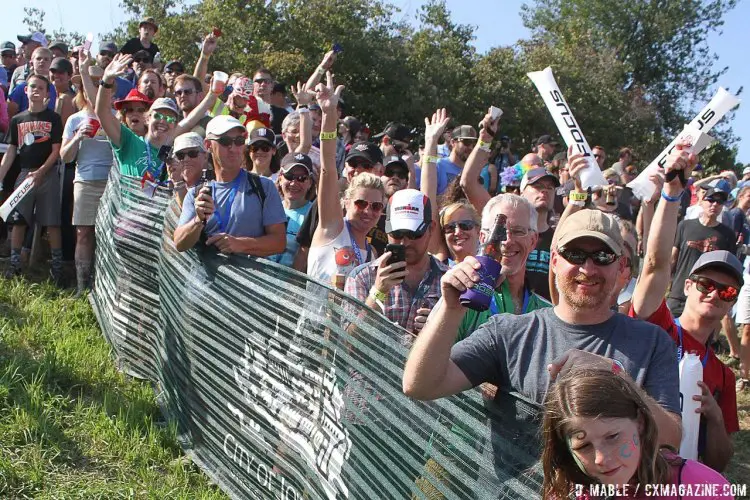
The crowds were out in force. 2016 Jingle Cross World Cup, Elite Women. © D. Mable / Cyclocross Magazine
CXM: Were there some highlights or best moments for you among all the chaos?
JM: Yeah, the coolest thing was looking out and seeing the crowds and seeing how big that crowd was. Everyone having a good time. People you don’t know coming up and patting you on the back and saying “Yeah, this is great. This is cool.” It was just fun from start to finish.
CXM: I have organized events before, and I always feel like 20 minutes before nerves can set in about people showing up. Were you happy with the crowds? Any worries?
JM: You always worry about that sort of thing, but when you watch the registrations, that really helps. We watch where our registrations go because our registration is also our crowd. We’re taking a little bit of a different approach this year. Not only do we want to get our cyclocross riders out there with some incentives, but we’re also trying to get the local people to come out. That’s why we’re putting on a Beers n’ Gears Oktoberfest celebration. It’s a three-day beer festival during the event. We hope people come out who might not know anything about bike racing or cyclocross. Come out and just want to see what is this beer festival and this bike race behind me at the same time. Maybe they’ll get caught up in the fever of the event.
That’s one thing we’re trying to do this year. We’ve added some additional events to try to entice the cyclocross riders to try something new. We’re doing a time trial where you’re going to race on the World Cup course where you do one lap all-out and we’ll compare it to the World Cup times. We’re also going to have a cyclocross relay race. That’s going to be right before the World Cup starts. Teams of four riders, all men, all women and then co-ed teams doing one lap per rider. It should be a lot of fun. It will be a little chaotic, but a lot of fun.
CXM: Looking ahead to 2017, any other changes we can expect? Any course changes you can tease?
JM: I think we’re going to make Friday as close to the World Cup as we can. Friday is going to be your chance to race the World Cup course. Come race Friday and you’re going to race the World Cup course. Saturday will be another chance to race. We’ve always had Friday night racing and Saturday day racing, and now we’re doing two nights. Musco Lighting out of Iowa is doing night time racing for the pro races both Friday and Saturday night.
CXM: That’s cool. Having attended the Friday night races, I think there really are few things better in cyclocross than Friday night on Mt. Krumpit, so kind of exciting to hear it will be two days of that.
JM: It’s going to be a big DJ and beer party with bands playing, DJs playing. The Beers n’ Gears festival going. All kinds of great things happening Friday and Saturday night. Registration is open. The Fondo is something that is going to be really spectacular this year. We’re contemplating adding some timed sections to the Fondo. Jason McCartney, our rider from year two and now the guy on my team who helps put on the race, is in charge of the Fondo and will be there for celebrity signings and you can ride with him as well.
CXM: Is the Grinch one of the celebrity signers?
JM: Yeah, I guess the Grinch could be one of the celebrities. Oh, another thing we’re having this year is a Doggie Cross.
CXM: A Doggie Cross?
JM: Doggie Cross. Right after the kids’ race with the Grinch, on the same course,the kids are going to ride on, you have to pick up your dog and carry the dog over the barriers.
CXM: With the bike, or are people going to be running with their dogs?
JM: They’re going to be running with their dogs.
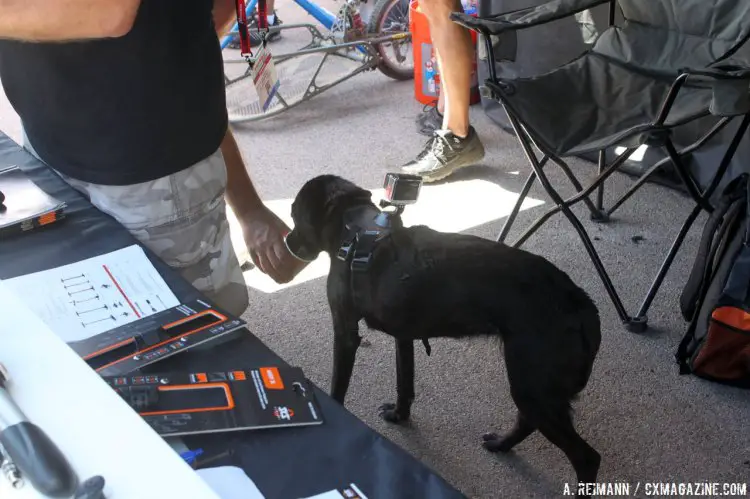
The Dog Days of Summer will extend into September with Doggie Cross at the 2017 Jingle Cross Festival. © Cyclocross Magazine
CXM: Speaking of elite athletes, how are you on commitments from the European riders? I know the travel was kind of a challenge last year.
JM: I think after our success last year and with the closeness of Trek’s Waterloo World Cup nearby, I think we’re going to see a lot more of the European riders come over because it will be a lot more economical for them. The transfer from Vegas to here was a big challenge for everybody. Now with the two World Cups being closer together on U.S. soil, you’re going to see a lot more come over. Plus with the success of how good our World Cup was and how challenging the course was, everybody is talking about it. I think they’re going to be coming over to get another shot at this course and those that haven’t been over are going to want to experience it.
CXM: What kind of advice would you give to the folks at Trek working on World Cup Waterloo?
JM: I am very excited Trek has decided to be part of this World Cup movement. It’s a ton of fun. Our advice to them is to have fun. Obviously, they’ve got a great venue, great course, great people up there. We’re excited we’re going to kind of be their partners for this year, one weekend to the next. If they’re successful, we’re successful. That’s what we really want to focus on, that this entire thing is successful for everybody. It’s a friendly, I don’t look at it as a competition, it’s a friendly partnership. I think how well they do is how well we do.
CXM: Have you given any thought to year number three?
JM: Yes we have, but we need to get to year number two before we move to that.
CXM: We’ll leave it there. Dot dot dot.
JM: I think a World Cup presence for North America is critical over the next several years. If it’s not us, I hope other race directors and programs across the U.S. pick it up. Our intention is to re-visit it after this year and make future plans. We have a great event and it’s not going to be any different in terms of its appeal after this year. We would like to continue pursuing this when it’s possible, but we also understand the need for growth in this sport. You need multiple locations across the U.S. to keep it rolling. I think it’s important for the race directors and folks to look at their opportunities and see what’s feasible. You don’t want them to overstretch themselves because that’s a disaster. But if they can do it, they should.
CXM: Trek is offering equal pay for both the men and women. Has that movement changed your approach to the financials you’re offering?
JM: That brings up a good point. We have done equal prize money for all C1 and C2 events for many years, where many races did not, including Trek. They did it for the first three spots for a while, but they didn’t do it all the way through like we did. The difference in prize money for a World Cup is huge. I would love to do equal prize money if we could. I do believe in that movement. I think we, having done C1 equal prize money, have a lot to do with why that’s now a rule. We did it a rule for years before it was a rule.
The fact is, financially, we are all volunteers and we do this out of love for the sport. Trek is an 850 million dollar company with 1,800 stores in U.S. alone, so they have a lot more resources than we do. And we applaud them for doing this very important move. I hope that movement will continue, and we would love to do it when we have the finances to do so. We will not have those finances for this year though.
CXM: Thanks again for taking the time to talk to me. It’s been great to speak with the Grinch or the Grinch’s alter ego.
JM: No worries. Thank you.
The 2017 Jingle Cross Festival will be held September 15-17 in Iowa City, IA. The World Cup race will be on Sunday, September 17. Please see all of our coverage of Jingle Cross and all of the interviews from our audio interview series.

























